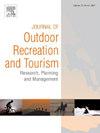Recreation ‘home range’: Motivations and use of green spaces along an urban—peri-urban continuum
IF 4.4
3区 管理学
Q1 HOSPITALITY, LEISURE, SPORT & TOURISM
Journal of Outdoor Recreation and Tourism-Research Planning and Management
Pub Date : 2024-11-30
DOI:10.1016/j.jort.2024.100838
引用次数: 0
Abstract
The attractiveness of urban forests for people is complex, influenced by culture, social norms, and individual characteristics. The main factors include the occurrence and nature of accessibility (far-near), the availability of facilities (less-more), and the level of naturalness (less-more) in the landscapes. Urban areas most used for recreation, as streets and parks, are often those areas that are most developed by infrastructure and constructions. There seems to be a gap between stated preference, intentions and actual behaviour for recreation in an urban setting. In this study we aim to investigate the motivations for and actual use of six defined green space classes along the urban-peri-urban continuum, and how socio-demographic factors varied along this spectrum. We tested this by means of representative web-survey of the city of Oslo population (N = 1003), Norway. Recreational use frequency was highest in the inner-city built zone. The results confirm earlier research that socio-demographic variables vary along the urban-peri-urban continuum. That variation does not stop at the city's edge but extends into a gradient within the built zone. Our results show that many of the same motivations for visiting the inner-city are very similar to those desired by visitors to remote peri-urban natural areas. People's demand for peace and quiet, and escape from everyday routines, work, and stress are important motivations in the inner-city built zone. Our study results support research showing that parks, backcountry and wilderness are relative concepts defining inhabitants' recreational ‘home range’ as a function of their experiences and understanding of these spaces as nature. The findings have implications for recreation valuation and accounting.
休闲活动的“主场范围”:沿着城市-城市边缘连续体的绿色空间的动机和使用
城市森林对人们的吸引力是复杂的,受文化、社会规范和个人特征的影响。主要因素包括可达性的发生和性质(远近)、设施的可用性(少-多)和景观的自然程度(少-多)。最常用于娱乐的城市地区,如街道和公园,往往是那些基础设施和建筑最发达的地区。在城市环境中,人们对娱乐的既定偏好、意图和实际行为之间似乎存在差距。在这项研究中,我们的目标是调查城市-城市-城市连续体中六个定义的绿色空间类别的动机和实际使用情况,以及社会人口因素如何沿着这一光谱变化。我们通过对挪威奥斯陆市人口(N = 1003)的代表性网络调查来检验这一点。娱乐使用频率最高的是内城建成区。结果证实了早期的研究,即社会人口变量沿着城市-城市边缘连续体变化。这种变化并没有停留在城市的边缘,而是延伸到建成区域内的梯度。我们的研究结果表明,许多访问市中心的动机与游客访问偏远的城市周边自然区域的动机非常相似。人们对和平与宁静的需求,以及对日常生活、工作和压力的逃避,是内城建成区的重要动机。我们的研究结果支持了一项研究,即公园、边远地区和荒野是相对的概念,定义了居民的休闲“家园范围”,作为他们对这些空间的体验和理解的功能。研究结果对娱乐价值评估和会计具有启示意义。
本文章由计算机程序翻译,如有差异,请以英文原文为准。
求助全文
约1分钟内获得全文
求助全文
来源期刊

Journal of Outdoor Recreation and Tourism-Research Planning and Management
HOSPITALITY, LEISURE, SPORT & TOURISM-
CiteScore
6.70
自引率
5.30%
发文量
84
期刊介绍:
Journal of Outdoor Recreation and Tourism offers a dedicated outlet for research relevant to social sciences and natural resources. The journal publishes peer reviewed original research on all aspects of outdoor recreation planning and management, covering the entire spectrum of settings from wilderness to urban outdoor recreation opportunities. It also focuses on new products and findings in nature based tourism and park management. JORT is an interdisciplinary and transdisciplinary journal, articles may focus on any aspect of theory, method, or concept of outdoor recreation research, planning or management, and interdisciplinary work is especially welcome, and may be of a theoretical and/or a case study nature. Depending on the topic of investigation, articles may be positioned within one academic discipline, or draw from several disciplines in an integrative manner, with overarching relevance to social sciences and natural resources. JORT is international in scope and attracts scholars from all reaches of the world to facilitate the exchange of ideas. As such, the journal enhances understanding of scientific knowledge, empirical results, and practitioners'' needs. Therefore in JORT each article is accompanied by an executive summary, written by the editors or authors, highlighting the planning and management relevant aspects of the article.
 求助内容:
求助内容: 应助结果提醒方式:
应助结果提醒方式:


